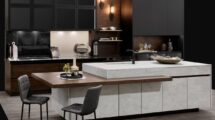Lifescape
By Janet Armstrong, Accredited Interior Designer, CAPS
As we continue to live in the homes we view as our safe havens and comfortable refuges, subtle and sometimes not so subtle health changes take place that can challenge our everyday habits and patterns of living. Being proactive and planning ahead provide an opportunity to make thoughtful, intentional choices without the pressure of trying to accommodate a sudden health change that requires quickly completed renovations and rushed decisions. Bathrooms are one of the primary updates required in homes to ensure safe access and functionality to support daily living. Numerous options are available that ensure safety and result in a beautiful, functional space.

The entrance to the bathroom should be one of the first considerations. The door opening must be a minimum of 33.85 inches wide to facilitate wheelchair access. The doorway to your bathroom may need to be widened to provide accessibility and reverse hinges on the door will allow maximum use of the full opening to facilitate entrance and exit from the room.
Non-slip flooring is essential to safe access and use, since a bathroom is a space with high moisture and humidity. Luxury Vinyl Tile (LVT) is an excellent product, known for its low maintenance, durability, warmth and non-slip properties. Available in a broad range of colours, it is waterproof and able to withstand humidity and temperature changes. Comfortable underfoot, it also allows mobility aids to easily move along its surface.
Vanities can be subtly accessible and functional too. Leaving the space beneath without shelves or drawers can provide plenty of room to allow someone to access the sink and mirror from a seated position using a mobility device. Including drawers to one side can provide necessary storage and easy access to grooming products and tools. Motion sensor taps are a fantastic option and reduce reach and the need for strength to turn taps on and off.

A vanity installed at 30 to 32 inches maximizes comfort, access and independence for the user. Undermount sinks are not only stylish but they maximize available counter space and are easy maintenance as well. Wall mounted lighting on either side of the mirror improves visibility and reduces shadows. This helps when shaving or applying makeup.
I am a fan of wall-mounted toilets for a number of reasons. They provide ample space around and under them to facilitate easy access and use as well as easy cleaning, they can be installed at comfort height (17 to 19 inches, which is the required height for accessibility) and they require less space. Wall-mounted toilets are available with full bidet and dryer functionality which supports independence, dignity and improves cleanliness and hygiene.
Bear in mind that in future, your shower may need to accommodate not only the bather but an assistant as well. A curbless shower with no or partial walls is the best option for unimpeded access with a mobility device and can facilitate easy access for both the bather and assistant. A partial shower wall will work as long as there is a minimum of 32 inches to allow access to the shower by walker, wheelchair or wheeled shower chair.

Benches, whether built-in or attached to the shower wall, are a must to provide safe support for the bather. Handheld showerheads come with a hose that makes them flexible, movable and adjustable. These are ideal for those bathing from a seated position or with limited mobility, helping to decrease the risk of slipping or falling and facilitating a better bathing experience by allowing water to be directed to where it is needed. A final consideration is heating the floors, walls, ceiling and bench if it is built in, for a more comfortable bathing experience not to mention a delightful indulgence.
Heated towel racks are not only a beautiful way to display your towels, they also enhance your comfort when coming out of the shower. They also help to dry towels more quickly, minimizing the growth of mold and bacteria.
If a bathroom renovation is on your list of updates to support living in place, take your time planning the layout and selecting products to meet any future needs and ensure safe access and functionality. The result will be a bathroom that is not only stylish but beautiful and accessible to all.
Janet Armstrong (simplyswankdecor.ca) is a graduate of the Interior Design Institute of Canada, CAPS (Certified Aging in Place Specialist) and past chair of the Decorators and Designers Association of Canada (DDA Canada).






